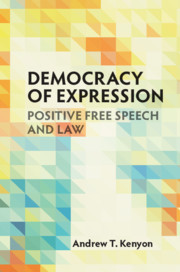Book contents
- Democracy of Expression
- Democracy of Expression
- Copyright page
- Contents
- Preface
- 1 Introduction
- 2 Positive Free Speech from Media Studies and Law
- 3 Positive Free Speech and Democracy
- 4 Positive Human Rights and Political Freedom
- 5 US Legal Writing on Positive Free Speech
- 6 German Broadcasting Freedom
- 7 French Freedom of Communication and Pluralism
- 8 Framing Communicative Freedom
- Bibliography
- Index
2 - Positive Free Speech from Media Studies and Law
Published online by Cambridge University Press: 28 May 2021
- Democracy of Expression
- Democracy of Expression
- Copyright page
- Contents
- Preface
- 1 Introduction
- 2 Positive Free Speech from Media Studies and Law
- 3 Positive Free Speech and Democracy
- 4 Positive Human Rights and Political Freedom
- 5 US Legal Writing on Positive Free Speech
- 6 German Broadcasting Freedom
- 7 French Freedom of Communication and Pluralism
- 8 Framing Communicative Freedom
- Bibliography
- Index
Summary
This chapter examines the idea of ‘sustained plural public speech’ and the place of positive free speech within it. Two models of diverse media, taken from media studies, illustrate the structural diversity within positive free speech. They suggest how constitutional speech protections could frame a democratic architecture for public speech, which should aim to support sustained plural public speech through diverse media entities, funding, missions and people. Legal research is used to consider how courts determine the meaning of freedom within free speech law, the positive freedom’s democratic rationale, some dubious assumptions that can underlie negative approaches to free speech, and the breadth of the positive freedom. Possible roles for judges and other actors are also considered. Later examples suggest the theoretical value in courts doing more, where others fail to act sufficiently, to support positive free speech by framing obligations for legislative, executive and regulatory action. This need may not be rare but central to democracy’s communicative requirements.
Keywords
- Type
- Chapter
- Information
- Democracy of ExpressionPositive Free Speech and Law, pp. 38 - 63Publisher: Cambridge University PressPrint publication year: 2021
- 1
- Cited by

